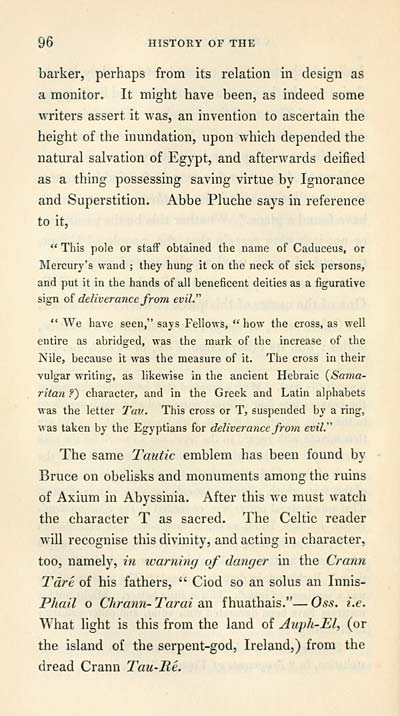Download files
Complete book:
Individual page:
Thumbnail gallery: Grid view | List view

96 HISTORY OF THE
barker, perhaps from its relation in design as
a monitor. It might have been, as indeed some
writers assert it was, an invention to ascertain the
height of the inundation, upon which depended the
natural salvation of Egypt, and afterwards deified
as a thing possessing saving virtue by Ignorance
and Superstition. Abbe Pluche says in reference
to it,
" This pole or staff obtained the name of Caduceus, or
Mercury's wand ; they hung it on the neck of sick persons,
and put it in the hands of all beneficent deities as a figurative
sign of deliverance from evil."
" We have seen," says Fellows, "how the cross, as well
entire as abridged, was the mark of the increase of the
Nile, because it was the measure of it. The cross in their
vulgar writing, as likewise in the ancient Hebraic (Sa7na-
ritan ?) character, and in the Greek and Latin alphabets
was the letter Tau. This cross or T, suspended by a ring,
was taken by the Egyptians for deliverance from evil''
The same Tautic emblem has been found by
Bruce on obelisks and monuments among the ruins
of Axium in Abyssinia. After this we must watch
the character T as sacred. The Celtic reader
will recognise this divinity, and acting in character,
too, namely, in tvarning of danger in the Crann
Tart of his fathers, " Ciod so an solus an Innis-
Phail o Chrann- Tarai an f huathais." — Oss. i.e.
What light is this from the land of Auph-El, (or
the island of the serpent-god, Ireland,) from the
dread Crann Tau-Ee.
barker, perhaps from its relation in design as
a monitor. It might have been, as indeed some
writers assert it was, an invention to ascertain the
height of the inundation, upon which depended the
natural salvation of Egypt, and afterwards deified
as a thing possessing saving virtue by Ignorance
and Superstition. Abbe Pluche says in reference
to it,
" This pole or staff obtained the name of Caduceus, or
Mercury's wand ; they hung it on the neck of sick persons,
and put it in the hands of all beneficent deities as a figurative
sign of deliverance from evil."
" We have seen," says Fellows, "how the cross, as well
entire as abridged, was the mark of the increase of the
Nile, because it was the measure of it. The cross in their
vulgar writing, as likewise in the ancient Hebraic (Sa7na-
ritan ?) character, and in the Greek and Latin alphabets
was the letter Tau. This cross or T, suspended by a ring,
was taken by the Egyptians for deliverance from evil''
The same Tautic emblem has been found by
Bruce on obelisks and monuments among the ruins
of Axium in Abyssinia. After this we must watch
the character T as sacred. The Celtic reader
will recognise this divinity, and acting in character,
too, namely, in tvarning of danger in the Crann
Tart of his fathers, " Ciod so an solus an Innis-
Phail o Chrann- Tarai an f huathais." — Oss. i.e.
What light is this from the land of Auph-El, (or
the island of the serpent-god, Ireland,) from the
dread Crann Tau-Ee.
Set display mode to: Large image | Transcription
Images and transcriptions on this page, including medium image downloads, may be used under the Creative Commons Attribution 4.0 International Licence unless otherwise stated. ![]()
| Early Gaelic Book Collections > Blair Collection > History of the Celtic language > (102) |
|---|
| Permanent URL | https://digital.nls.uk/76179731 |
|---|
| Description | A selection of books from a collection of more than 500 titles, mostly on religious and literary topics. Also includes some material dealing with other Celtic languages and societies. Collection created towards the end of the 19th century by Lady Evelyn Stewart Murray. |
|---|
| Description | Selected items from five 'Special and Named Printed Collections'. Includes books in Gaelic and other Celtic languages, works about the Gaels, their languages, literature, culture and history. |
|---|

